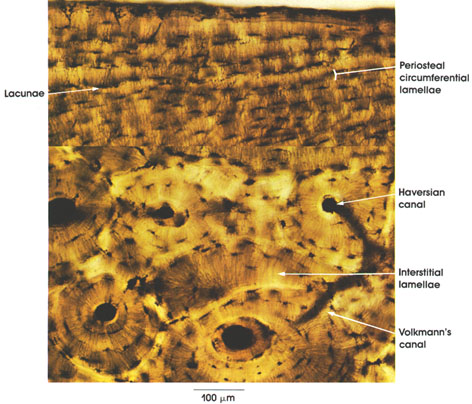

Compact cross section
Ronald A. Bergman, Ph.D., Adel K. Afifi, M.D., Paul M. Heidger,
Jr., Ph.D.
Peer Review Status: Externally Peer Reviewed

Human, ground bone, 162 x.
Haversian canals: These are abundant and characteristic of compact bone. Their course follows the main axis of long bone. They conduct blood vessels, lymphatics, and nerves throughout the bone. They branch and anastomose and become continuous with Volkmann's canals. Haversian* canals surrounded by concentric lamellae of compact bone form the Haversian system.
Volkmann's canals: These are cross connections between Haversian canals. They pierce the lamellae of two Haversian systems. They contain blood vessels, lymphatics, and nerves and supply the interstitial lamellae.
Interstitial lamellae: A set of bone lamellae that fill the spaces between Haversian systems. They vary in shape and orientation.
*Havers was a seventeenth-century English anatomist and Volkmann was a nineteenth-century German physiologist.
Next Page | Previous Page | Section Top | Title Page
Please send us comments by filling out our Comment Form.
All contents copyright © 1995-2025 the Author(s) and Michael P. D'Alessandro, M.D. All rights reserved.
"Anatomy Atlases", the Anatomy Atlases logo, and "A digital library of anatomy information" are all Trademarks of Michael P. D'Alessandro, M.D.
Anatomy Atlases is funded in whole by Michael P. D'Alessandro, M.D. Advertising is not accepted.
Your personal information remains confidential and is not sold, leased, or given to any third party be they reliable or not.
The information contained in Anatomy Atlases is not a substitute for the medical care and advice of your physician. There may be variations in treatment that your physician may recommend based on individual facts and circumstances.
URL: http://www.anatomyatlases.org/